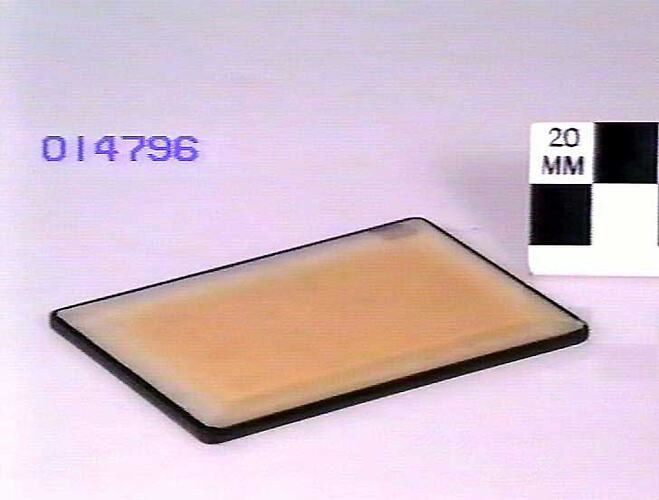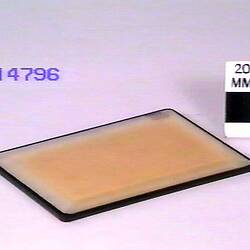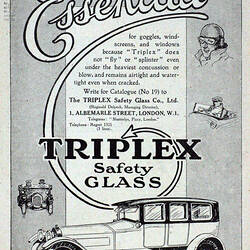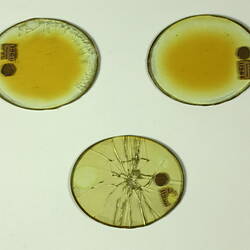Summary
Sample of "Triplex Safety Glass", rectangular piece 5½ in x 4 in, with bevelled edges.
Made up of two outside sheets of plate glass, with a sheet of 'Xylonite' (celluloid) sandwiched between them and cemented together with a special optical transparent cement.
Presented to the museum by the Gollin & Co Pty Ltd, Melbourne agents for the manufacturer, Triplex Safety Glass Co. Ltd, England. This early form of laminated safety glass was used for the windscreens of motor cars and aeroplanes, and for goggle glasses, in situations where breakage might be dangerous.
The Triplex Safety Glass Company Ltd was established by Reginald Delpech (1881-1935) in 1912, to manufacture laminated windscreen glass for motor vehicles in Britain under French patents. The relatively high cost of manufacture compared to plain glass windscreens initially restricted demand, but following the outbreak of World War I, the product found new widespread uses for gas masks, bullet proof glass and for the rapidly growing aviation industry, being adopted for both flying goggles by pioneering aviators such as Basil Watson, and for aircraft windscreens. In 1919, the "Triplex Safety Glass" trademark was registered in Australia and Triplex safety glass cowlings and windows were adopted by Handley Page Ltd to provide weather protection for the cockpits and passenger cabins of their new aircraft built for the London-Paris passenger route. By 1924, the company had relocated to Willesden, and then in 1927 purchased a new factory at King's Norton, Birmingham, with the support of a loan from Guest, Keen and Nettlefolds. In 1927, Pilkington developed a process for making thin plate glass particularly suitable for the Triplex process, and in 1929 the two firms formed a joint venture to establish the Triplex Imperial works at Eccleston, St. Helens. In 1946, the company introduced a new type of safety glass using vinyl as the laminate layer between sheets of toughened (annealed) glass. In 1972, the Triplex Safety Glass Co. Ltd became a wholly-owned subsidiary of Pilkington.
More Information
-
Collecting Areas
-
Acquisition Information
Donation from Gollin & Co Pty Ltd, Triplex Safety Glass Co Ltd, 03 May 1923
-
Manufacturer
Triplex Safety Glass Co Ltd, 1 Albemarle Street, Piccadilly, London, England, Great Britain, circa 1923
-
Brand Names
-
Classification
-
Category
-
Discipline
-
Type of item
-
Overall Dimensions
140 mm (Length), 102 mm (Width), 6 mm (Depth)
-
References
Triplex Safety Glass Co, Grace's Guide to British Industrial History, [Link 1] viewed 18/03/2017. Notes from original catalogue card: 'A note in ghe "Indus. Aust. & Min. Standard" 1/10/31 p.236 dates the patent for "safety glass" filed by Edouard Benedictus, a French poet, philosopher, chemist & inventor, who accidently obtained the idea in 1903 & made use of it some years later in devising the safety glass by putting a celluloid sheet between two of glass. The Triplex Coy. was the first to commercially exploit the invention.'
-
Keywords
Safety Glass, Air Transport, Celluloids, Materials Science, Road Transport, Safety Products




